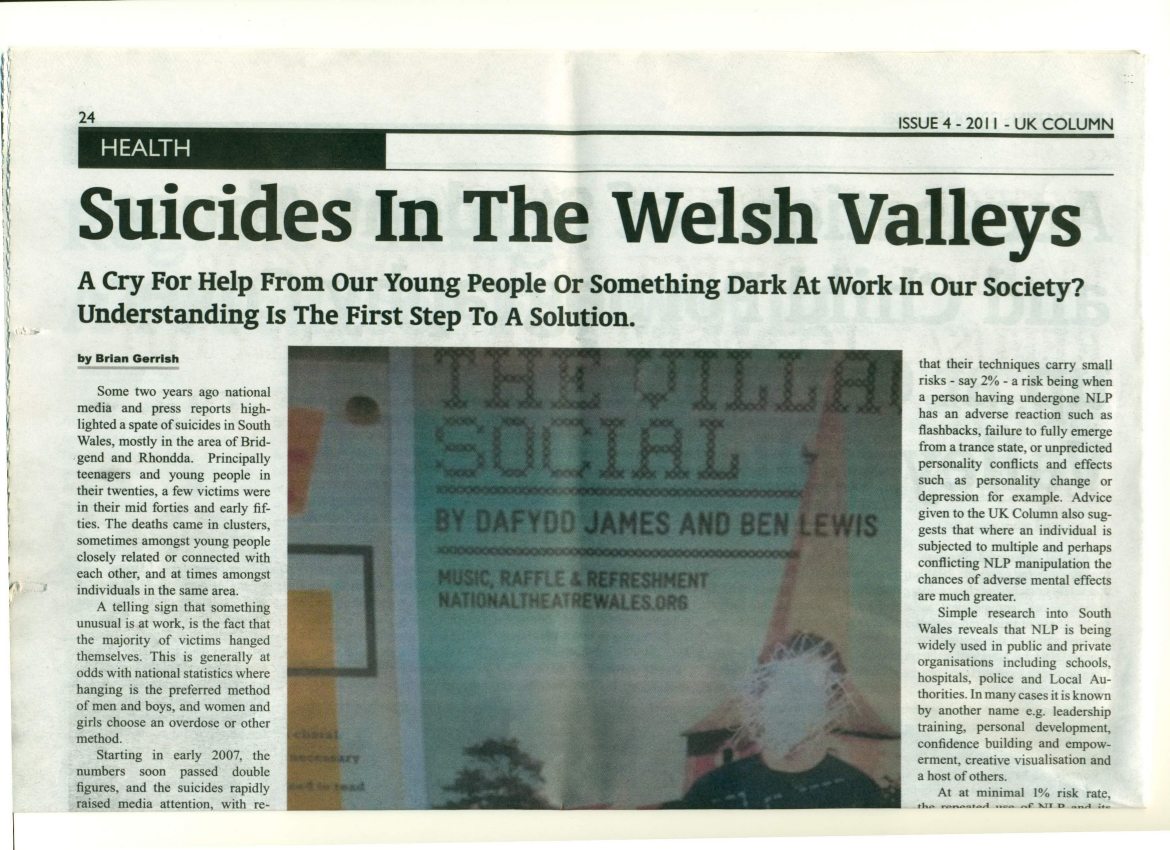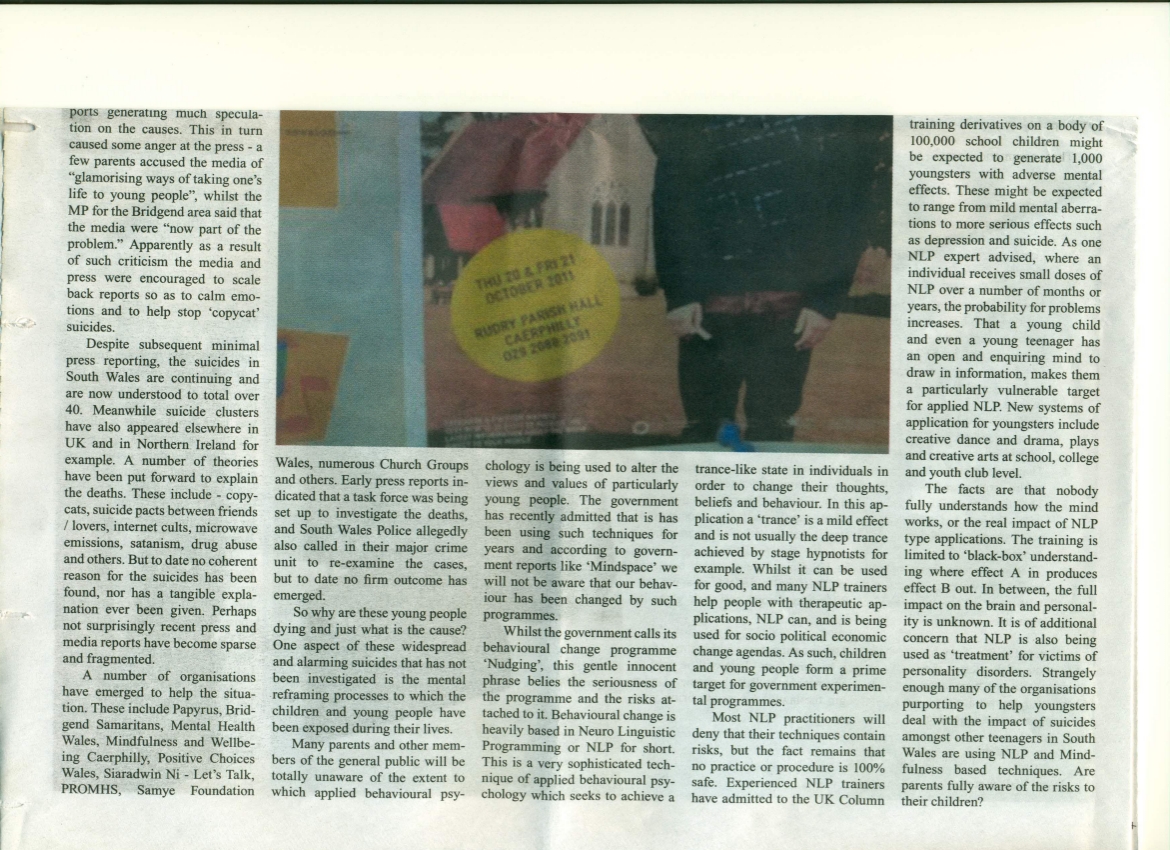Suicides in the Welsh Valleys
This important article, pertinent to this month's upcoming Saxon Messenger editorial, was found nowhere online, so we take the liberty to reproduce it here.
ISSUE 4 - 2011 - UK COLUMN – Page 24
Suicides In The Welsh Valleys: A Cry For Help From Our Young People Or Something Dark At Work In Our Society? Understanding Is The First Step To A Solution.
by Brian Gerrish
Some two years ago national media and press reports high lighted a spate of suicides in South Wales, mostly in the area of Bridgend and Rhondda. Principally teenagers and young people in their twenties, a few victims were in their mid forties and early fifties. The deaths came in clusters, sometimes amongst young people closely related or connected with each other, and at times amongst individuals in the same area.
A telling sign that something unusual is at work, is the fact that the majority of victims hanged themselves. This is generally at odds with national statistics where hanging is the preferred method of men and boys, and women and girls choose an overdose or other method.
Starting in early 2007, the numbers soon passed double figures, and the suicides rapidly raised media attention. with reports generating much speculation on the causes. This in turn caused some anger at the press - a few parents accused the media of "glamorising ways of taking one's life to young people", whilst the MP for the Bridgend area said that the media were "now part of the problem." Apparently as a result of such criticism the media and press were encouraged to scale back reports so as to calm emotions and to help stop 'copycat' suicides.
Despite subsequent minimal press reporting, the suicides in South Wales are continuing and are now understood to total over 40. Meanwhile suicide clusters have also appeared elsewhere in UK and in Northern Ireland for example. A number of theories have been put forward to explain the deaths. These include - copycats, suicide pacts between friends / lovers, internet cults, microwave emissions, satanism, drug abuse and others. But to date no coherent reason for the suicides has been found, nor has a tangible explanation ever been given. Perhaps not surprisingly recent press and media reports have become sparse and fragmented.
A number of organisations have emerged to help the situation. These include Papyrus, Bridgend Samaritans, Mental Health Wales, Mindfulness and Wellbeing Caerphilly, Positive Choices Wales, Siaradwin Ni - Let's Talk, PROMHS, Samye Foundation Wales, numerous Church Groups and others. Early press reports indicated that a task force was being set up to investigate the deaths, and South Wales Police allegedly also called in their major crime unit to re-examine the cases, but to date no firm outcome has emerged.
So why are these young people dying and just what is the cause? One aspect of these widespread and alarming suicides that has not been investigated is the mental reframing processes to which the children and young people have been exposed during their lives.
Many parents and other members of the general public will be totally unaware of the extent to which applied behavioural psychology is being used to alter the views and values of particularly young people. The government has recently admitted that is has been using such techniques for years and according to government reports like 'Mindspace' we will not be aware that our behaviour has been changed by such programmes.
Whilst the government calls its behavioural change programme 'Nudging', this gentle innocent phrase belies the seriousness of the programme and the risks attached to it, Behavioral change is heavily based in Neuro Linguistic Programming or NLP for short. This is a very sophisticated technique of applied behavioural psychology which seeks to achieve a trance-like state in individuals in order to change their thoughts, beliefs and behaviour. In this application a 'trance' is a mild effect and is not usually the deep trance achieved by stage hypnotists for example. Whilst it can be used for good, and many NLP trainers help people with therapeutic applications, NLP can, and is being used for sociopolitical economic change agendas. As such, children and young people form a prime target for government experimental programmes.
Most NLP practitioners will deny that their techniques contain risks, but the fact remains that no practice or procedure is 100% sate. Experienced NLP trainers have admitted to the UK Column that their techniques carry small risks - say 2% - a risk being when a person having undergone NLP has an adverse reaction such as flashbacks, failure to fully emerge from a trance state, or unpredicted personality conflicts and effects such as personality change or depression for example. Advice given to the UK Column also suggests that where an individual is subjected to multiple and perhaps conflicting NLP manipulation the chances of adverse mental effects are much greater.
Simple research into South Wales reveals that NLP is being widely used in public and private organisations including schools, hospitals. police and Local Authorities. In many cases it is known by another name e.g. leadership training, personal development, confidence building and empowerment, creative visualisation and a host of others.
At a minimal 1% risk rate, the reported use of NLP and its training derivatives on a body of 100,000 school children might be expected to generate 1,000 youngsters with adverse mental effects. These might be expected to range from mild mental aberrations to more serious effects such as depression and suicide. As one NLP expert advised, where an individual receives small doses of NLP over a number of months or years, the probability for problems increases. That a young child and even a young teenager has an open and enquiring mind to draw in information, makes them a particularly vulnerable target for applied NLP. New systems of application for youngsters include creative dance and drama, plays and creative arts at school, college and youth club level.
The facts are that nobody fully understands how the mind works, or the real impact of NLP type applications. The training is limited to 'black-box' understand ing where effect A in produces effect B out. In between, the full impact on the brain and personality is unknown. It is of additional concern that NLP is also being used as 'treatment' for victims of personality disorders. Strangely enough many of the organisations purporting to help youngsters deal with the impact of suicides amongst other teenagers in South Wales are using NLP and Mind fulness based techniques. Are parents fully aware of the risks to their children?


- Log in to post comments






